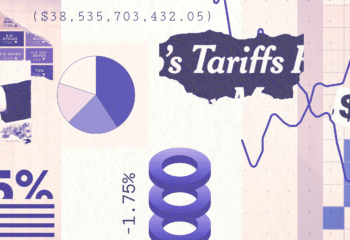The future is always uncertain—this is true no matter which period of history you look at, and it’s definitely true right now. Over the last several weeks, financial markets have been volatile because of uncertainty about the impact and extent of tariffs. While we can’t know for sure how long these policies will persist, there are some inferences and thoughts I can offer with some confidence.
Historically, tariffs have had both inflationary and deflationary effects. They can be inflationary in the sense that, while some portion of any tariff will be paid by sellers, some portion will also be paid by the buyer in the form of higher prices. For this reason, you can probably expect at least a one-time increase in the prices of many items. But tariffs can also be deflationary in the sense that, by virtue of increasing prices, they can be expected to dampen demand and slow down economic activity. Together, these effects can sometimes (but do not always) combine to create what’s known as “stagflation,” which is when prices increase at the same time economic activity slows down.
The current tariff situation is still unfolding. Stagflation is not guaranteed, but more market volatility seems likely. So what is the best guidance we can provide during these notably uncertain times?
The first, and probably most important, piece of advice is that investors should not panic and make any alterations to a well thought-out investment plan. One of the biggest mistakes an investor can make is to sell out during times of extreme uncertainty. Emotional reactions to stock market fluctuations have been shown to prevent investors from realizing the long-term returns offered by financial markets. So as hard as it might be to avoid acting from emotional panic generated by a fluctuating stock market, staying the course is likely to work out in your favor over the long term.
A time-tested way to manage risk as an investor is to hold a broadly diversified portfolio that includes exposure to foreign and emerging markets in addition to US stocks, which is why we include these asset classes in our recommended portfolios. Diversification will not eliminate losses, but it should moderate them. And if you are a young investor saving for retirement, know that staying in the market for long periods of time will give you an opportunity to recover when the storm finally passes.
Some investors are concerned about a possible recession. If you want to protect yourself from this possibility, it makes sense to build up an adequate emergency fund in an interest-bearing account where your funds will be readily accessible. Cash provides liquidity for short-term needs and unexpected expenses, and it’s also a stabilizer to help protect the value of your total portfolio.
If we enter a prolonged period of stagflation like what the US encountered in the 1970s, it will be a difficult time for financial markets, but there are still steps you can take to help protect your investments. One of those steps is continuing to make regular investments over time. Let’s take a closer look at how this approach has helped investors in the past.
Over the six-year period from the beginning of 1973 to the end of 1978, the annualized total return (including reinvested dividends) of the US equity market was only 1.20%. However, investors who made consistent deposits through this period fared better. Someone who invested an equal amount at the end of each month would have earned an annualized return of 7.28%. The table below shows the market’s return each year during this period, as well as the total amount invested and the portfolio value at the end of each year (just before the final monthly deposit for that year), for a hypothetical investor depositing $100 per month. Crucially, much of that return was gained from regular buying during the most unnerving months of this period because our hypothetical investor was able to buy more shares at times when prices were at their lowest.
| Year | Market Return | Total Investment | Portfolio Value |
| 1973 | -19.3% | $1,200 | $1,085 |
| 1974 | -27.7% | $2,400 | $1,797 |
| 1975 | 38.2% | $3,600 | $3,784 |
| 1976 | 27.0% | $4,800 | $6,127 |
| 1977 | -3.1% | $6,000 | $7,152 |
| 1978 | 8.2% | $7,200 | $8,886 |
We encourage young investors with long time horizons and the financial means to view periods of financial turbulence like what we’re experiencing today as an opportunity. No one knows exactly what the future holds, but historical data suggests there is benefit to staying the course and continuing to make steady investments over time.
You may also be able to improve your after-tax returns by engaging in tax-loss harvesting. Tax-loss harvesting is a strategy that has long been available to wealthy investors through high-end advisors, but Wealthfront was an early pioneer in automating it and making it more broadly available. Wealthfront’s Tax-Loss Harvesting has saved clients an estimated $1.09 billion in taxes over the last ten years, and in the first three market days following the tariff announcement on April 2, Wealthfront’s Tax-Loss Harvesting was able to take advantage of the heightened volatility to harvest over $100 million in losses to help lower clients’ tax bills. (Keep in mind that this was an abnormally volatile period, which allowed our software to harvest more than it would in a typical three-day period. Investors should not expect this rate of tax-loss harvesting in more typical market conditions.)
We know the current market environment is unusually uncertain, and it’s human to wonder what action you should take in this circumstance. But before you make any changes to your strategy, we encourage you to consider the advice offered by the White Rabbit in Alice in Wonderland: “Don’t just do something, stand there.”
Disclosure
The information contained in this blog is provided for general informational purposes only, and should not be construed as investment or tax advice. Nothing in this communication should be construed as a solicitation or offer, or recommendation, to buy or sell any security. Any links provided to other server sites are offered as a matter of convenience and are not intended to imply that Wealthfront Advisers or its affiliates endorses, sponsors, promotes and/or is affiliated with the owners of or participants in those sites, or endorses any information contained on those sites, unless expressly stated otherwise.
The effectiveness of the tax-loss harvesting strategy to reduce the tax liability of the client will depend on the client’s entire tax and investment profile, including purchases and dispositions in a client’s (or client’s spouse’s) accounts outside of Wealthfront Advisers and type of investments (e.g., taxable or nontaxable) or holding period (e.g., short-term or long-term).
Tax-loss harvesting may generate a higher number of trades due to attempts to capture losses. There is a chance that trading attributed to tax-loss harvesting may create capital gains and wash sales and could be subject to higher transaction costs and market impacts. In addition, tax loss harvesting strategies may produce losses, which may not be offset by sufficient gains in the account and may be limited to a $3,000 deduction against income. The utilization of losses harvested through the strategy will depend upon the recognition of capital gains in the same or a future tax period, and in addition may be subject to limitations under applicable tax laws, e.g., if there are insufficient realized gains in the tax period, the use of harvested losses may be limited to a $3,000 deduction against income and distributions. Losses harvested through the strategy that are not utilized in the tax period when recognized (e.g., because of insufficient capital gains and/or significant capital loss carryforwards), generally may be carried forward to offset future capital gains, if any.
Diversification, asset allocation, and automated investing do not guarantee profit or ensure against loss. Investor experiences can vary widely based on strategies and time horizons. Index funds and ETFs generally offer broad diversification, but may still expose investors to specific market, sector, or asset class risks. Wealthfront provides investment management services but may not achieve returns comparable to those of the general market or specific benchmarks.
Investment management and advisory services are provided by Wealthfront Advisers LLC (“Wealthfront Advisers”), an SEC-registered investment adviser, and brokerage related products, including the Cash Account, are provided by Wealthfront Brokerage LLC (“Wealthfront Brokerage”), a Member of FINRA/SIPC. Wealthfront Advisers and Wealthfront Brokerage are wholly-owned subsidiaries of Wealthfront Corporation.
All investing involves risk, including the possible loss of money you invest, and past performance does not guarantee future performance. Please see our Full Disclosure for further information.
Copyright 2025 Wealthfront Corporation. All rights reserved.
About the author(s)
Dr. Burton G. Malkiel, the Chemical Bank Chairman’s Professor of Economics, Emeritus, and Senior Economist at Princeton University, is Wealthfront's Chief Investment Officer. Dr. Malkiel is the author of the widely read investment book, A Random Walk Down Wall Street, which helped launch the low-cost investing revolution by encouraging institutional and individual investors to use index funds. Dr. Malkiel, also the author of The Elements of Investing, is one of the country’s leading investor advocates. View all posts by



